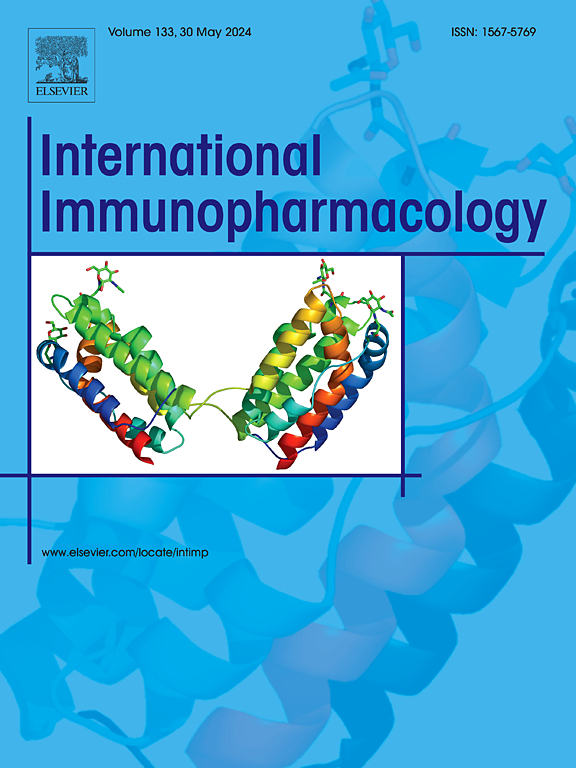Unraveling the therapeutic mechanisms of Bufei Yiqi decoction in pulmonary fibrosis: Modulation of autophagy and glycolysis pathways
IF 4.8
2区 医学
Q2 IMMUNOLOGY
引用次数: 0
Abstract
Pulmonary fibrosis (PF) is a chronic, progressive lung disease marked by excessive collagen deposition and inflammation. Bufei Yiqi Decoction (BFYQD), a traditional Chinese herbal formula, has shown potential in treating PF, but its mechanisms remain unclear. This study aimed to explore BFYQD's therapeutic effects on PF, focusing on its regulation of glycolysis and autophagy via the phosphoinositide 3-kinase/protein kinase B (PI3K/Akt) pathway, providing a foundation for its clinical application. A PF mouse model was established using bleomycin (BLM). Nontargeted metabolomics, network pharmacology, and transcriptomics were integrated to identify dysregulated pathways. Molecular docking assessed binding affinities between BFYQD compounds and targets. Western blot, biochemical assays, and histopathological staining validated findings. Serum metabolomics identified bioactive compounds. Multi-omics analysis revealed PI3K/Akt as a key regulator of glycolysis in PF. Quercetin, kaempferol, and glabridin were identified as bioactive compounds in BFYQD, showing strong binding to PI3K/Akt pathway proteins. BFYQD suppressed PI3K, Akt, mTOR, and HIF-1α phosphorylation, reducing glycolysis and enhancing autophagy. Histopathological analysis confirmed reduced fibrosis and epithelial-mesenchymal transition (EMT). BFYQD alleviates PF by modulating glycolysis and autophagy via the PI3K/Akt pathway. Its bioactive compounds, such as quercetin and kaempferol, offer a novel therapeutic strategy for PF.
补肺益气汤治疗肺纤维化的机制:自噬和糖酵解途径的调节
肺纤维化(PF)是一种慢性进行性肺部疾病,以过度胶原沉积和炎症为特征。补肺益气汤(BFYQD)是一种传统的中草药配方,已显示出治疗PF的潜力,但其机制尚不清楚。本研究旨在探讨BFYQD对PF的治疗作用,重点研究其通过磷酸肌苷3-激酶/蛋白激酶B (PI3K/Akt)通路调控糖酵解和自噬,为其临床应用提供基础。用博来霉素(BLM)建立PF小鼠模型。非靶向代谢组学、网络药理学和转录组学被整合以确定失调的途径。分子对接评估BFYQD化合物与靶标之间的结合亲和力。Western blot、生化分析和组织病理学染色证实了结果。血清代谢组学鉴定出生物活性化合物。多组学分析显示PI3K/Akt是PF中糖酵解的关键调控因子,槲皮素、山奈酚和光甘草定是BFYQD中的生物活性化合物,与PI3K/Akt通路蛋白结合较强。BFYQD抑制PI3K、Akt、mTOR和HIF-1α磷酸化,减少糖酵解,增强自噬。组织病理学分析证实纤维化减少和上皮-间质转化(EMT)。BFYQD通过PI3K/Akt通路调节糖酵解和自噬来缓解PF。其生物活性化合物,如槲皮素和山奈酚,为PF提供了一种新的治疗策略。
本文章由计算机程序翻译,如有差异,请以英文原文为准。
求助全文
约1分钟内获得全文
求助全文
来源期刊
CiteScore
8.40
自引率
3.60%
发文量
935
审稿时长
53 days
期刊介绍:
International Immunopharmacology is the primary vehicle for the publication of original research papers pertinent to the overlapping areas of immunology, pharmacology, cytokine biology, immunotherapy, immunopathology and immunotoxicology. Review articles that encompass these subjects are also welcome.
The subject material appropriate for submission includes:
• Clinical studies employing immunotherapy of any type including the use of: bacterial and chemical agents; thymic hormones, interferon, lymphokines, etc., in transplantation and diseases such as cancer, immunodeficiency, chronic infection and allergic, inflammatory or autoimmune disorders.
• Studies on the mechanisms of action of these agents for specific parameters of immune competence as well as the overall clinical state.
• Pre-clinical animal studies and in vitro studies on mechanisms of action with immunopotentiators, immunomodulators, immunoadjuvants and other pharmacological agents active on cells participating in immune or allergic responses.
• Pharmacological compounds, microbial products and toxicological agents that affect the lymphoid system, and their mechanisms of action.
• Agents that activate genes or modify transcription and translation within the immune response.
• Substances activated, generated, or released through immunologic or related pathways that are pharmacologically active.
• Production, function and regulation of cytokines and their receptors.
• Classical pharmacological studies on the effects of chemokines and bioactive factors released during immunological reactions.

 求助内容:
求助内容: 应助结果提醒方式:
应助结果提醒方式:


